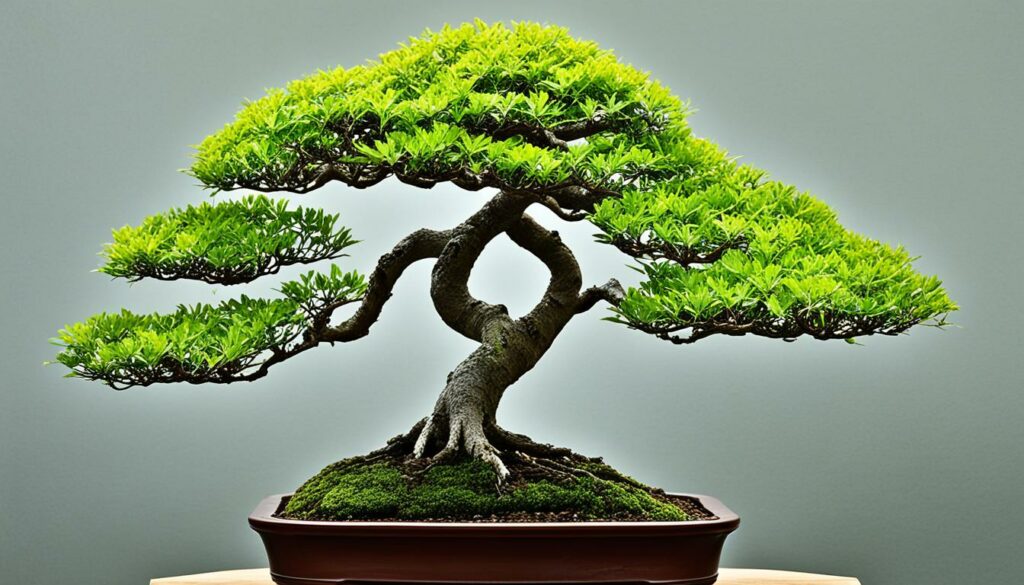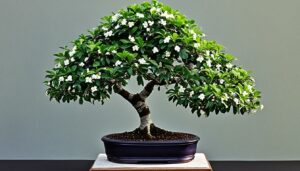In this guide, you will learn about cultivating Ash bonsai, also known as Fraxinus bonsai. This deciduous bonsai species has gained popularity for its resilience and charming appearance.
The Ash bonsai tree is a versatile species that can be grown in different styles and sizes, making it a fascinating option for bonsai enthusiasts. If you are interested in cultivating an Ash bonsai tree, read on to discover more about this species and how to care for it.
Key Takeaways:
- The Ash bonsai is a deciduous species known for its resilience.
- Fraxinus bonsai is its scientific name.
- Ash bonsai trees can be grown in different styles and sizes.
- Proper care is essential for the health and vitality of your Ash bonsai tree.
- Styling and pruning techniques can be used to create an aesthetically pleasing design.
Introduction to Ash Bonsai Trees
Ash bonsai trees are a popular choice among bonsai enthusiasts for their unique characteristics. Belonging to the Fraxinus genus, these trees are native to regions of North America, Europe, and Asia. The word ‘Fraxinus’ is derived from the Latin term for ‘lightweight’ due to the lightweight nature of the wood used in making tools and sports equipment.
Ash bonsai trees are deciduous, meaning they lose their leaves during autumn. They have a strong, sturdy trunk that can grow up to several feet in diameter and a dense branching structure that produces beautiful foliage.
The distinctive features of Ash bonsai trees include their compound leaves and winged seeds that grow in clusters. The leaves can measure up to 8 inches in length and have up to nine leaflets. The seeds, also known as ‘keys’, have a flat, wing-like structure that enables them to be carried by the wind over long distances.
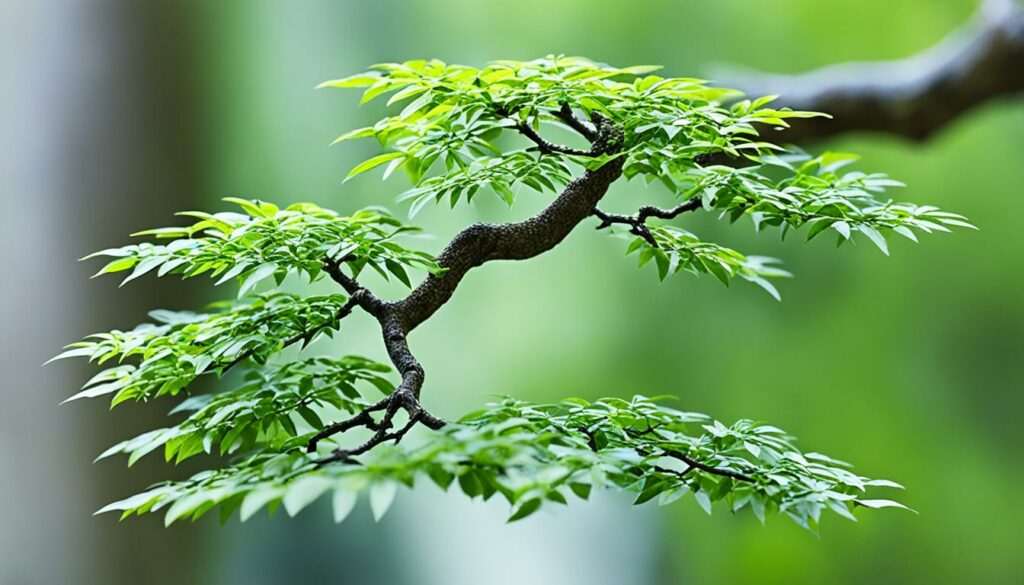
As bonsai trees, Ash trees are known for their resilience and adaptability to various environmental conditions. In the next section, we will explore the factors to consider when selecting an Ash bonsai tree for your collection.
Selecting the Right Ash Bonsai Tree
Choosing the perfect Ash bonsai tree is an essential step towards a successful bonsai journey. With various options available, it’s crucial to consider several factors when selecting the right one for you.
One of the primary factors to consider is the size of the tree, which should be proportional to the pot it is planted in. You should also consider the age of the tree, as younger trees are more malleable and easier to shape than older ones. Trunk thickness is another pivotal aspect, as thicker trunks add to the overall aesthetic appeal of the bonsai tree.
It’s important to assess the tree’s roots when selecting an Ash bonsai tree. A healthy root system is essential for the tree’s development and growth.
Keep in mind that selecting an Ash bonsai tree involves knowing your skill level as well. Beginners should opt for younger trees that need little maintenance, while experienced gardeners can challenge their skills with more complex trees.
Factors to consider when selecting an Ash bonsai tree
| Factor | Importance |
|---|---|
| Size | Proportional to the pot |
| Age | Younger trees are more malleable |
| Trunk thickness | Thicker trunks add to aesthetic appeal |
| Root system | Healthy roots are essential for development and growth |
| Skill level | Choose a tree appropriate for your experience level |
By considering these factors and evaluating your skill level, you can choose the perfect Ash bonsai tree for your cultivation and embark on a successful bonsai journey.
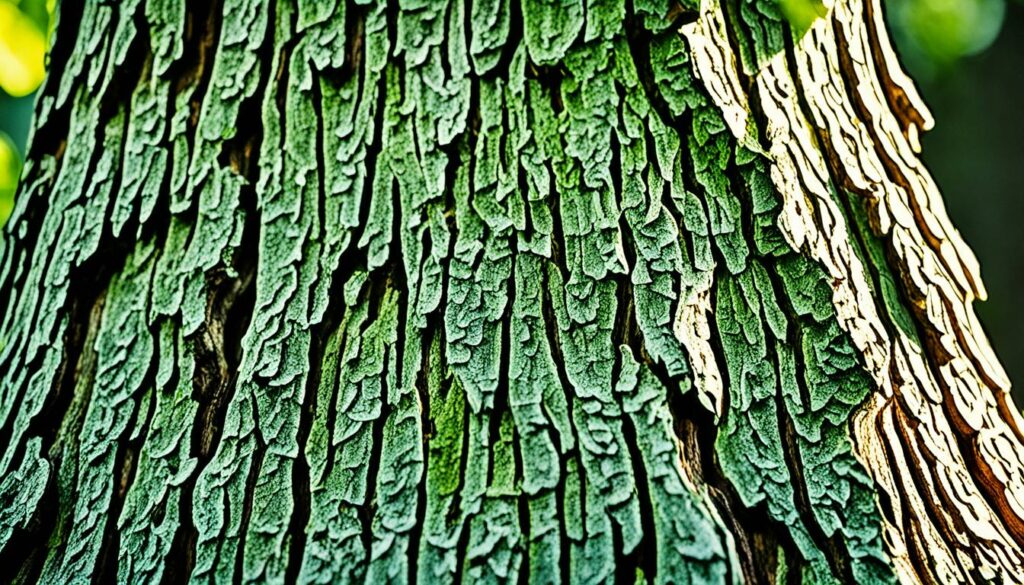
Caring for Ash Bonsai Trees
Proper care is essential for the health and vitality of your Ash bonsai tree. Ash bonsai trees require adequate sunlight, water, and nutrients, as well as regular pruning and maintenance. Here are some specific care requirements to follow:
Watering
Ash bonsai trees prefer a moist but well-drained soil. Water your tree when the soil feels slightly dry to the touch. Avoid overwatering, as this can lead to root rot. Ensure proper drainage by using a well-draining soil mix and a container with drainage holes.
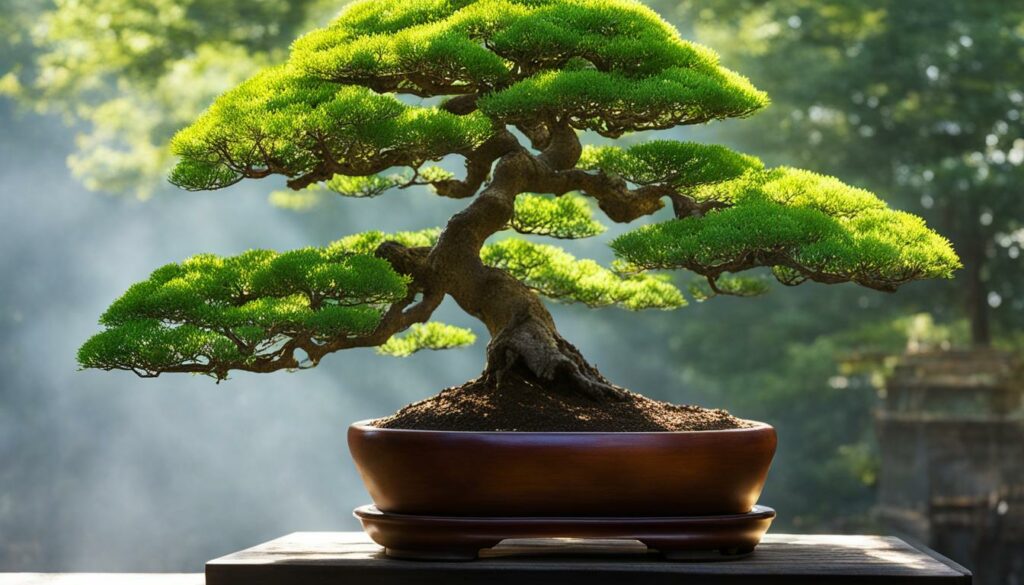
Pruning
Regular pruning helps to maintain the shape and size of your Ash bonsai tree. Remove any dead, damaged, or diseased branches as soon as possible. Use sharp pruning shears to make clean cuts and avoid damaging healthy branches.
Wiring
Wiring can be used to shape and guide the growth of your Ash bonsai tree. However, care must be taken to avoid damaging or cutting off circulation to the branches. Use flexible, lightweight wire and wrap it around the branch in a gentle, spiral motion. Remove the wire as soon as the branch has set in the desired shape.
Repotting
Ash bonsai trees should be repotted every two to three years, or when the roots have outgrown the container. Repotting should be done in the spring or fall, using a well-draining soil mix. Gently loosen and prune the roots before repotting to promote healthy growth.
“Regular pruning helps to maintain the shape and size of your Ash bonsai tree.”
Styling and Pruning Techniques for Ash Bonsai Trees
One of the most exciting aspects of owning an Ash bonsai tree is the opportunity to style and prune it to your liking. With careful pruning and styling, you can transform your Ash bonsai into a stunning work of art.
Before pruning your tree, be sure to have a clear idea of the design you wish to create. This will help you prune the right branches and shape the foliage in the desired manner.
Pruning Techniques for Ash Bonsai Trees
When it comes to pruning your Ash bonsai tree, there are several techniques you can use to achieve the desired shape and size. Here are a few of the most common:
- Pinch pruning: This technique involves removing the tips of new growth to encourage branching and fullness in the foliage.
- Thinning: This technique involves selectively removing small, unneeded branches to increase light and air penetration.
- Branch cutting: This technique involves cutting back larger branches to promote regrowth in a different direction.
Each of these pruning techniques serves a specific purpose in the overall design of your Ash bonsai tree. It is essential to understand the effect of each pruning style and how it will impact the development of your tree.
Styling Methods for Ash Bonsai Trees
There are many different styling methods you can use to create a unique and eye-catching design for your Ash bonsai tree. Here are some of the most popular techniques:
- Informal upright: This style features a slight curve in the trunk with strong, upward-growing branches. It represents the natural shape of the tree in its natural habitat.
- Formal upright: This style is characterized by a straight trunk with symmetrical branches. It is a classic shape often seen in traditional bonsai designs.
- Slanting: This style features a trunk that leans to the right or left, with branches growing in the opposite direction.
Experimenting with different pruning and styling techniques can add variety and interest to your collection of Ash bonsai trees.
“Styling and pruning an Ash bonsai tree is both a science and an art. With these techniques, you can create a unique and beautiful tree that reflects your vision and creativity.”
Common Pests and Diseases of Ash Bonsai Trees
While Ash bonsai trees are known for their hardiness, they can still fall prey to pests and diseases like any other plant. It is crucial to identify and treat issues promptly to prevent further damage to your bonsai tree.
One of the most common pests affecting Ash bonsai trees is the aphid. These small insects feed on the leaves and sap of the tree, leaving behind a sticky residue known as honeydew. To get rid of aphids, montgamet soap or neem oil can be used.
Scale insects are another common problem for Ash bonsai trees. These pests attach themselves to the branches and trunk of the tree, sucking out the sap and causing damage. To treat scale insects, you can use a cotton swab dipped in rubbing alcohol to remove them manually or apply horticultural oil.
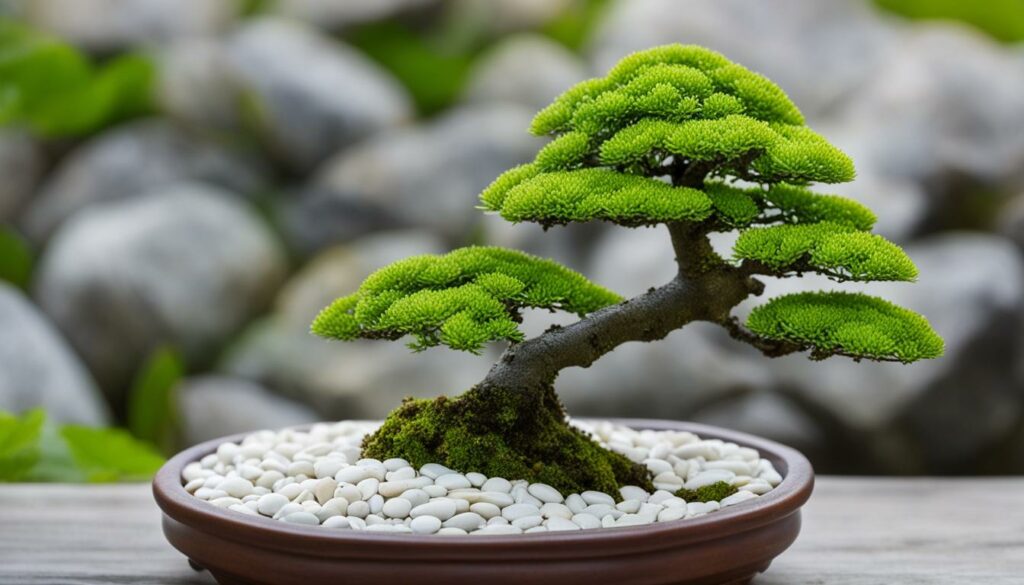
Ash bonsai tree with aphids
Ash bonsai trees are also susceptible to powdery mildew, a fungal disease that results in a white, powdery coating on the leaves and stems. To prevent powdery mildew, ensure proper air circulation and avoid wetting the leaves when watering. You can use fungal sprays as a treatment, or prune away the affected areas.
Fungal Diseases in Ash Bonsai Trees
Fungal infections can also affect Ash bonsai trees, posing a significant threat to their health and survival. One of the most common fungal diseases is root rot, which occurs when the tree’s roots are exposed to excess moisture or poor drainage. To prevent root rot, avoid overwatering and ensure your bonsai pot has sufficient drainage holes. If you suspect root rot, remove the affected roots and repot the tree in fresh, well-draining soil.
| Disease/Pest | Symptoms | Treatment |
|---|---|---|
| Aphids | Small insects feeding on leaves and sap, honeydew residue | Use montgamet soap or neem oil |
| Scale Insects | Pests attached to branches and trunk, sucking sap and causing damage | Use a cotton swab and rubbing alcohol or horticultural oil |
| Powdery Mildew | White, powdery coating on leaves and stems | Ensure proper air circulation, avoid getting leaves wet, use fungal sprays or prune affected areas |
| Root Rot | Soft, blackened roots with a foul odor | Remove affected roots, repot in fresh, well-draining soil |
By keeping a watchful eye for potential pest and disease problems and treating them promptly, you can ensure the long-term health and beauty of your Ash bonsai tree.
Showcasing Ash Bonsai Tree Species
Ash bonsai trees are a captivating addition to any bonsai collection. They can be displayed in various ways to showcase their elegance and charm. Here are some display options to consider:
Accent Plants
Pairing Ash bonsai trees with complimentary accent plants is a common display technique. Tiny ferns, mosses, or ivies are often used to enhance the beauty of the tree. It’s important to choose accent plants that naturally grow in the same habitat as Ash bonsai trees to create a harmonious display.
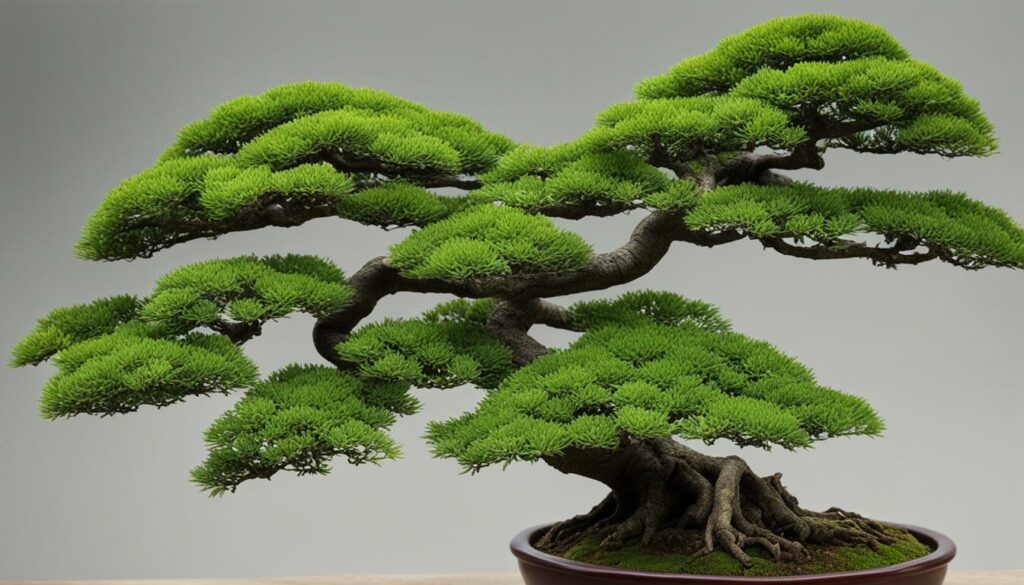
Containers
The choice of container for an Ash bonsai tree can greatly impact its visual appeal. Traditional blue-glazed pots are a popular choice for Ash bonsai trees, as they provide a complementary contrast to the tree’s green foliage. Terra cotta and wooden containers are also great options that highlight the natural beauty of the tree.
Exhibitions Techniques
Ash bonsai trees can be displayed using exhibition techniques to highlight their unique features. This can include accentuating the tree’s trunk by tilting it to one side or positioning it to catch the light in a certain way. Consider using a display stand to elevate the tree and provide a better view of its beauty.
By experimenting with different display options and combinations, you can create a captivating and visually stunning display of your Ash bonsai trees.
Conclusion
Congratulations on completing this guide on Ash bonsai trees! By now, you should have a better understanding of the unique characteristics of this deciduous bonsai species and how to care for them properly.
Remember, selecting the right Ash bonsai tree is crucial for a successful bonsai journey. Consider the size, age, and trunk thickness when choosing a tree, and ensure it receives the proper care, including watering, pruning, wiring, and repotting.
To create an aesthetically pleasing design, experiment with various pruning techniques and styling methods. However, be aware of common pests and diseases that Ash bonsai trees are susceptible to and take steps to prevent and treat them.
Finally, showcase your beautiful Ash bonsai tree through various display options, including accent plants, containers, and exhibition techniques. With patience and dedication, you can cultivate a sturdy and charming Ash bonsai tree that will bring tranquility to your bonsai collection.
FAQ
Can I grow an Ash bonsai indoors?
While Ash bonsai trees can tolerate a wide range of conditions, they are best suited for outdoor cultivation. These trees require ample sunlight and proper air circulation to thrive. However, you can place your Ash bonsai indoors for shorter periods, ensuring it receives sufficient natural light, or use grow lights to supplement the light requirements.
How often should I water my Ash bonsai tree?
The watering frequency for Ash bonsai trees varies depending on factors such as climate, season, and soil conditions. As a general guideline, water your Ash bonsai thoroughly when the top layer of soil feels slightly dry to the touch. Avoid overwatering, as it can lead to root rot. Regularly check the moisture levels and adjust the watering schedule accordingly.
When should I prune my Ash bonsai tree?
Pruning is an essential aspect of Ash bonsai tree care and is typically done during late winter or early spring, before the tree enters the active growing season. This timing promotes new growth and allows the tree to recover quickly. Remove any dead, diseased, or unwanted branches using sharp bonsai pruning shears, making clean cuts just above the branch collar.
Can I wire the branches of my Ash bonsai tree?
Yes, you can wire the branches of your Ash bonsai tree to guide their growth and create desired shapes. However, exercise caution and avoid applying excessive pressure, as Ash wood can be prone to breaking. Use bonsai wire of appropriate thickness and remove it before it cuts into the bark. Regularly inspect the branches to prevent wire scarring.
What are the common pests and diseases that affect Ash bonsai trees?
Ash bonsai trees can be vulnerable to pests such as aphids, spider mites, and scale insects. Additionally, they may face diseases like powdery mildew and root rot if their care requirements are not met. Regularly inspect your Ash bonsai tree for any signs of pests or diseases, and take appropriate measures such as using insecticides or adjusting watering practices.
Can I display my Ash bonsai tree in a ceramic pot?
Absolutely! Ceramic pots are a popular choice for showcasing Ash bonsai trees. The sturdy and decorative nature of ceramic pots complements the elegance of Ash bonsai trees. Ensure that the pot has proper drainage holes and place your Ash bonsai tree in well-draining bonsai soil for optimal growth and health.
